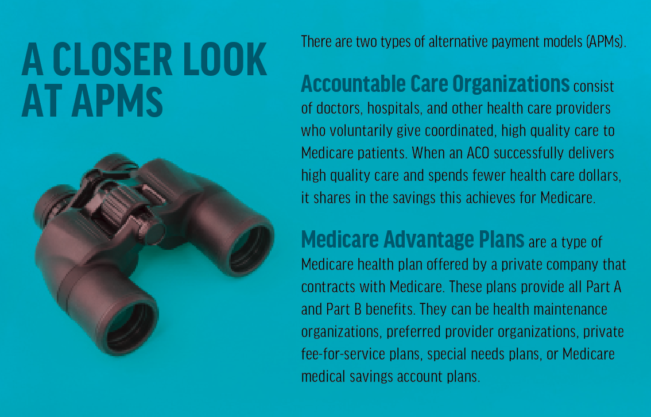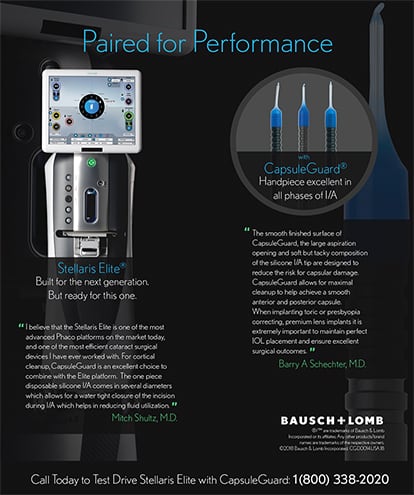QPP, MIPS, APM, ACO, MA, VCP—these acronyms stand for programs, concepts, and organizations that will dramatically affect how optometrists practice and are paid for their services in the coming years. Providers who do not adapt to these changes may find themselves left behind or, worst case, see their practices fail financially.
Although optometric scope of practice has dramatically expanded, optometrists still find themselves walking a fine line between the old model of refractive care and the newer model of medical care. This is because most optometric practices serve two different worlds: the world of refractive care, controlled by vision care plans (VCPs), and the world of medical care, opened to them by Medicare and other major medical plans that have classified optometrists as physician providers.
This article examines some of the forces that will be acting on optometry in the coming years and offers suggestions regarding how to deal with these two worlds in order to survive and thrive.
VCPs and Medical Eye Care
VCPs send many patients to ODs for refractive care, and they are also now trying to have ODs provide medical eye care services for extremely discounted fees. Further, some VCPs are taking income away from practices by contacting patients directly and offering them discounts on eyeglasses and contact lenses purchased online through VCP-owned websites. In other words, even though VCPs rely on ODs to be participating providers in order to sell contracts to employers, they are also becoming competitors of ODs, diverting away income from sales of materials. This is a problem that is going to get worse, and optometrists who rely on VCP patients for the majority of their income are going to find their practices suffering financially.
While dealing with these challenges related to VCP participation, optometrists must also adapt to significant changes in the world of medical eye care. Many of these changes are driven by the CMS, which controls the Medicare and Medicaid programs, and by the other insurance carriers that tend to adopt the billing, documentation, and reimbursement policies set by CMS. As ODs increase their share of medical eye care services to combat the downward financial pressure on their practices from VCPs, they must also deal with stagnant fees for medical eye care. In addition, they risk fee penalties if they do not comply with the CMS quality reporting criteria for medical care.
In the past, providers had to worry about whether their records met the documentation criteria established within the Current Procedural Terminology and International Classification of Diseases coding systems. Now they have other worries. Because of CMS initiatives such as the Quality Payment Program and Merit Based Incentive Payment System (MIPS), providers have to adopt expensive electronic health record systems and meet strict online security and reporting requirements in order to at least attempt to maintain their fees for service.1,2
Cost Controls
CMS and other insurers are now monitoring the cost of care for patients with certain diagnoses. Failure to meet cost guidelines in the future could mean being removed from a provider panel, whereas meeting or exceeding the guidelines could lead to receiving a bonus.
CMS has also established what are called alternative payment models (APMs) that require provider groups to accept a certain level of financial risk when caring for Medicare patients.3 Two current types of APM are accountable care organizations (ACOs) and Medicare Advantage (MA) plans. Over the next few years, CMS hopes to enroll more than 80% of Medicare patients in APMs.
Unfortunately for many optometrists, these APMs are not required to honor the any willing provider provisions followed by standard Medicare plans. Therefore, many providers may find themselves unable to care for long-established patients if they are not credentialed for these APMs.
What to Do
In light of these dramatic changes, how can ODs protect the financial viability of their practices while utilizing their patient care skills and taking full advantage of their expanded scope of practice?
First, they need to be sure they are billing, coding, and documenting properly in order to receive the maximum reimbursement to which they are entitled for their services. In my work as a certified coder, I often do record and coding audits for practices. I have found that most of my clients are losing tens of thousands of dollars per year in justifiable fees due to improper coding for patient services.
To help ease the documentation criteria for evaluation and management (E/M) codes, CMS has begun a program called Patients Over Paperwork to allow providers to spend more time speaking with and caring for patients rather than typing repetitive information into patient records.4 Although this program may lead to providers receiving the same fee for various E/M codes in a couple of years, it will also reduce documentation and decrease audit risk.
It is crucial that eligible ODs participate in the MIPS reporting program. Not participating subjects providers to Medicare fee penalties of up to 9% for each year they do not report. These fee penalties can add up to a cumulative decrease of 25% or more. What’s more, non-Medicare insurance plans are beginning to emulate these programs.
Participation with ACOs and MAs is also crucial. More Medicare patients will be shifting to these plans as significant incentives are offered for them to do so. In some areas where these plans may discriminate against optometrists, working through state and national associations to gain provider privileges may be necessary.
Another area requiring caution is the frequency of billing for procedures. Does that patient with mild superficial punctate keratitis really need an expensive amniotic membrane? Does this glaucoma suspect really require OCT and visual field testing quarterly? Practices such as these have led to significant fee decreases, strict testing frequency guidelines, and even code changes (such as those for electroretinography) over the past several years.
Stay Flexible
Above all, to deal with these changes and thrive in the dual world of refractive and medical eye care, optometrists need to be flexible and be able to make practice changes when needed. Those who keep up with this tide of changes will flourish. Those who do not will struggle to survive.
- CMS Panel Discussion on E/M Coding Reform. www.youtube.com/watch?v=W2QBTQNxfSY. Accessed June 14, 2019.
- Centers for Medicare and Medicaid Services. MLN Connects. November 1, 2018. Physician Fee Schedule and QPP: Changes to Advance Innovation, Restore Focus on Patients. https://www.cms.gov/Outreach-and-Education/Outreach/FFSProvPartProg/Provider-Partnership-Email-Archive-Items/2018-11-01-eNews-SE.html#physician. Accessed June 10, 2019.
- Final policy, payment, and quality provisions changes to the Medicare physician fee schedule for calendar year 2019. Centers for Medicare & Medicaid Services. November 1, 2018. www.cms.gov/newsroom/fact-sheets/final-policy-payment-and-quality-provisions-changes-medicare-physician-fee-schedule-calendar-year. Accessed June 14, 2019.
- Centers for Medicare and Medicaid Services. What is Patients Over Paperwork? https://www.cms.gov/Outreach-and-Education/Outreach/Partnerships/PatientsOverPaperwork.html. Accessed June 10, 2019.







